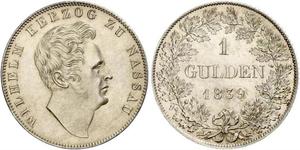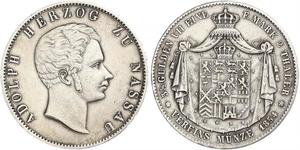| preceded by | |
|
|
| succeeded by |
| Duchy of Nassau (1806 - 1866)from the Wikipedia | Read original article |
| This article needs additional citations for verification. (September 2014) |
| Duchy of Nassau | ||||||
| Herzogtum Nassau (de) | ||||||
| State of the Confederation of the Rhine (1806–1813) State of the German Confederation (1815–1866) |
||||||
|
||||||
|
||||||
|
The Duchy of Nassau in 1815.
|
||||||
| Capital | Weilburg (1806–1816) Wiesbaden (1816–1866) |
|||||
| Languages | German | |||||
| Government | Constitutional monarchy | |||||
| Duke of Nassau | ||||||
| • | 1806–1816 | Frederick Augustus | ||||
| • | 1816–1839 | William | ||||
| • | 1839–1866 | Adolph | ||||
| Historical era | Modern era | |||||
| • | Established | 30 August 1806 | ||||
| • | Annexed by Prussia | 23 August 1866 | ||||
| Currency | Kronenthaler | |||||
The Duchy of Nassau (German: Herzogtum Nassau), or simply Nassau, was an independent state between 1806 and 1866, located in what is now the German states of Rhineland-Palatinate and Hesse. It was a member of the Confederation of the Rhine and later of the German Confederation. Its ruling dynasty, now extinct, was the House of Nassau. The duchy was named for its historical core city, Nassau, although Nassau was not its capital. As of 1865, it had 465,636 inhabitants. After being occupied and annexed into the Kingdom of Prussia in 1866, it was succeeded by the Province of Hesse-Nassau. The area today is a geographical and historical region, Nassau, and Nassau is also the name of the Nassau Nature Park within the borders of the former duchy.
Today, the Grand Duke of Luxembourg still uses "Duke of Nassau" as his secondary title (of pretense), and "Prince" or "Princess of Nassau" is used as a title of pretense by other members of the grand ducal family. Nassau is also part of the name of the Dutch Royal Family, which styles itself Orange-Nassau.
History[edit]

On 17 July 1806, the remaining counties of Nassau-Usingen and Nassau-Weilburg joined the Confederation of the Rhine. Under pressure from Napoleon I both counties merged to form the Duchy of Nassau on 30 August 1806, under the joint rule of Frederick Augustus, and his younger cousin Frederick William. As Frederick August had no heirs, he agreed that Frederick William should become sole ruler after his death. However Frederick William died from a fall on the stairs at Weilburg Castle on 9 January 1816, and it was his son William who became Duke of Nassau.
At the Congress of Vienna, the Principality of Orange-Nassau was incorporated into the Duchy of Nassau and subsequently the unified Duchy joined the German Confederation with Wiesbaden as its new capital. Through the extinction of most lines, the Nassau-Usingen branch of the Nassau-Weilburg line under Duke William became the reigning house of Nassau until the Austro-Prussian War in 1866, when it was annexed by the Kingdom of Prussia and incorporated as the Wiesbaden Region into the Province of Hesse-Nassau. William's son Adolphe, the last Duke of Nassau, received Luxembourg after the male line of Nassau-Dillenburg became extinct in 1890.[1]
References[edit]
- ^ "Image Gallery of the Coins of Nassau". Retrieved December 2013.
|
|||||||||||||||||||||||||||||||||||||||||||||||||||
|
|||||||||||||||||||||||||||||||||||||||||
- Former countries in Europe
- Former vassal states
- States and territories established in 1806
- States and territories disestablished in 1866
- States of the Confederation of the Rhine
- States of the German Confederation
- Former states and territories of Rhineland-Palatinate
- Duchy of Nassau
- 1806 establishments in Europe
- 1866 disestablishments in Europe













